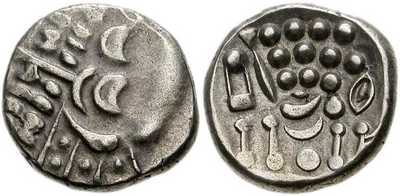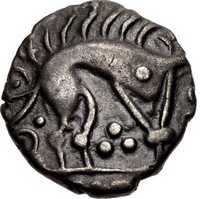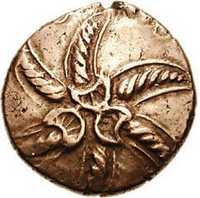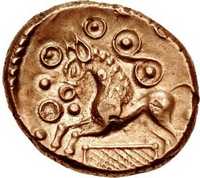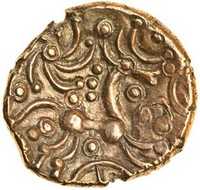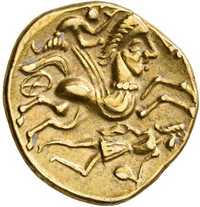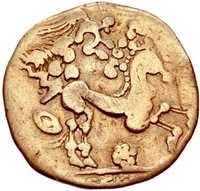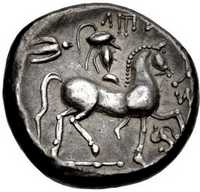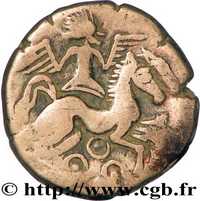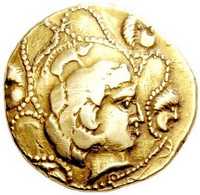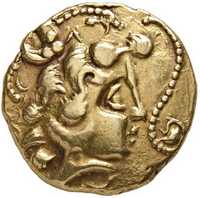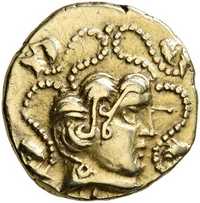| Back to Describing Celtic Coins | This page is part of the article Getting Started with Celtic Coins | Forward to Further Reading About the Art on Celtic Coins |
“This need to look behind the surface of Celtic coin types has made a happy hunting ground for the crankish interpreter in pursuit of devious religious symbolism”
Derek Allen
There has been plenty of speculation about the meaning of the imagery on Celtic coins, but no real consensus has been reached. The problem is that the Celts didn’t write anything down, and the only people who could confirm any theories have been dead for 2,000 years. As no theories can ever be proven to be correct, some numismatists avoid reading any meaning at all into the images.
However, just because a problem is hard doesn’t mean it should just be ignored. There are some basic questions that the images could help to answer, such as who minted the coin, when and why. More than that though, having some theories about the meanings makes the coins more interesting to collect, and not being sure what they mean can lead the collector into studying Celtic history and art. This can’t be a bad thing.
There are too many Celtic coins to try and discuss them all, so the focus here is restricted to some of the coins from Gaul and Britain. Specifically, the focus is only on coins created after the Celts had transitioned beyond just copying the original prototype, but before they started adopting Romanised images.
Why Horses?
It’s not clear why the horse was chosen as the dominant animal on Celtic coins. There were plenty of Greek coins without horses that they could have copied, and they could have abandoned the horse at any stage, but on gold staters, which were the most prestigious of coins, this was rarely done. Even in the case of the Gallo-Belgic E staters, which were minted in their millions while Caesar was invading Gaul, the Celts faithfully maintained a horse on the reverse rather than just produce blank, or simplified, coins.
There are three major theories about this, and all could be correct at the same time. The first is that the horse had religious connotations, such as being the symbol of an important God (to do with money or the purpose of money), or by being a liminal animal that could provide a conduit to the gods. Tacticus says of the Germanic tribes in 98 AD:
Although the familiar method of seeking information from the cries and the flight of birds is known to the Germans, they have also a special method of their own – to try to obtain omens and warnings from horses. These horses are kept at the public expense in the sacred woods and groves that I have mentioned; they are pure white and unclefiled by any toil in the service of man. The priest and the king, or the chief of the state, yoke them to a sacred chariot and walk beside them, taking note of their neighs and snorts. No kind of omen inspires greater trust, not only among the common people, but even among the nobles and priests, who think that they themselves are but servants of the gods, whereas the horses are privy to the gods’ counsels.
The Germanic tribes weren’t Celts, but it is possible that similar beliefs were held by them at the time.
The second theory about why the horse was used so often is that the horse was a symbol of the warrior elite in Celtic society, and these were the people minting and receiving the high-value gold coins.
The third theory is that the horse featured prominently in Celtic mythology, and I’ll cover than next.
Lunar and Solar Imagery or Something More?
It is generally assumed that many of the symbols on the abstract Celtic coins represent the sun, the stars and the moon, and probably do so for religious reasons.
The Sun Photo Copyright Oxford University & The Portable Antiquities Scheme (CC BY-SA 4.0) | The Moon and stars Photo Copyright Mike Vosper Coins |
This doesn’t account for every symbol that was used, but it gives a good framework for analysing the coins, and ties in well with some of the Celtic mythology that we know about. For example, Daphne Nash Briggs tells of the ancient belief that the sun was pulled across the heavens every day in a chariot, returning every night on the ocean. The Greeks had the driver of the chariot as Apollo; the Celts as Belenus. She also tells of another myth about the sun maiden and her brothers (the twins in the Gemini constellation). The sun is chased in her chariot through the daylight sky by monsters of the night, who capture her at sunset. Her brothers rescue her and sail her home through the night, defeating the chasing monsters.
Photo Copyright Oxford University & The Portable Antiquities Scheme (CC BY-SA 4.0) | Photo Copyright Hammered British Coins |
These quarter staters appear to show a boat with two occupants sailing right to left (when looking south at the sun, that would be west to east). The one on the left shows a figure (female?) at the front of the boat with a sunburst ahead, with another figure (male?) at the rear fighting a snake. The coin on the right shows a similar scene, but with the snake at the front obscuring the sunburst, and a batch of stars behind.
In another paper, Daphne Nash Briggs discusses the horses involved in the above story, commenting that at night the horse returned, pulling the other side of the sun with it. She highlights coins such as the one below where:
- The metal looks silver rather than gold, representing the moon rather than the sun
- The horse faces left (east) which is the direction it would travel at night
- The horse looks tired, droopy, and appears to have a nose bag
- The horse appears to have a dim sun-like disc below it
- The horse has twelve moons on its back plus a smaller object about one third their size. There are twelve and one third lunar months in a year
Photo Copyright Classical Numismatic Group, LLC
Other examples of lunary and solar mythology on Celtic coins can be found in some of the non-horse animals occasionally used. One popular set of coins for collectors are the Iceni’s Norfolk Wolf staters which feature a wolf where the horse would normally be. According to legend, which we still know of through Norse writing, both the sun and the moon were chased through the sky by the wolves Skoll and Hati. Norfolk Wolf Left Type staters show a wolf chasing the sun, and Norfolk Wolf Right Type staters show a wolf about to eat a crescent moon.
Photo Copyright Oxford University & The Portable Antiquities Scheme (CC BY-SA 4.0) | Norfolk Wolf Right Type Photo Copyright Mike Vosper Coins |
The most common animal on Celtic coins after the horse is the boar, which is a dark haired animal with curved white tusks that look like crescent moons.
Photo Copyright Classical Numismatic Group, LLC | Photo Copyright Classical Numismatic Group, LLC | Photo Copyright Classical Numismatic Group, LLC |
Like all pigs, boars spend a lot of their time digging, having a fascination for what’s below the ground. It is believed that the boar on coins symbolised the underworld and the night which is why it is rare to be seen on gold coins.
While the argument that some Celtic coins featured astral imagery is convincing, it doesn’t account for every symbol used, or help us explain many coins which don’t tie in so nicely with known Celtic mythology. Take the Yarmouth stater (ABC 518) for example:
The head on the obverse has no face, but instead has a three-pronged nose with a crescent below that which has three claw-like crescents hanging from it. To the right is a bell-shaped shrimp-like object. The reverse features a right facing horse with a claw for a tail, and forelegs that can best be described as spinning blades with a claw on one of them.
The only sensible theory about the imagery on this coin is that the engraver was tripping on drugs when he came up with the design. As frivolous as that sounds, it may actually be correct. John Creighton, in “Coins and Power in Late Iron Age Britain” makes a convincing case that the art on Celtic coins was derived from trance imagery.
There are three stages people go through when entering a trance. To begin with, they see shapes and patterns that are artefacts of the optical system (entoptics or phosphenes), such as starbursts, dots and spirals. As they go deeper into the trance, some of these merge to form objects from the person’s own experiences, with other shapes continuing to float around in the background. In the final stage of the trance the objects become lifelike, “often combined with a blinding shaft of white light, commonly described as a tunnel or whirlpool” ( Creighton), and still with the entoptics and phosphenes in the background. All of this can be seen on Celtic coins.
Shapes such as starbursts, dots and spirals:
Photo Copyright Classical Numismatic Group, LLC | Photo Copyright Classical Numismatic Group, LLC | Photo Copyright Classical Numismatic Group, LLC |
Shapes coalescing into familiar objects:
Photo Copyright Classical Numismatic Group, LLC | Photo Copyright Classical Numismatic Group, LLC | Photo Copyright Classical Numismatic Group, LLC |
Shapes becoming lifelike, sometimes with a vortex or rotating tunnel:
PhotoCopyright Spink and Son Ltd | Photo Copyright Classical Numismatic Group, LLC | |
Photo Copyright Classical Numismatic Group, LLC | Photo Copyright Spink and Son Ltd | Photo Copyright Classical Numismatic Group, LLC |
People who have reached the third trance stage have reported experiencing three common themes:
- Turning into an animal
- Flying or weightlessness
- Out-of-body experience – floating away from their bodies but still being connected by a thin thread
Again, all of these themes are common on Celtic coins.
Turning into an animal:
Photo Copyright Leu Numismatik AG | Photo Copyright Classical Numismatic Group, LLC | Photo Copyright Classical Numismatic Group, LLC |
Flying or weightlessness:
Photo Copyright Classical Numismatic Group, LLC | Photo Copyright Classical Numismatic Group, LLC | Photo Copyright CGB Numismatique Paris |
Out-of-body experience:
Photo Copyright Classical Numismatic Group, LLC | Photo Copyright Numismatica Ars Classica NAC AG Auction 72, Lot 812] | Photo Copyright Leu Numismatik AG |
Apollo, or Someone Else?
The obverse images on coins derived from the gold stater of Phillip II feature a very abstracted head of Apollo. Apollo was the Greek sun god who rode his chariot across the sky every day, returning home at night sailing across the ocean. The Celts didn’t get their gods from Greece, but they will have known that the image on the Phillip II staters represented the sun god, which to them would be Belenus. Therefore, by putting the head of Apollo on the obverse, even in highly abstracted form, the Celts were marking these small golden discs with the sun god.
Due to the extreme abstraction of Apollo’s head, we need to consider the possibility that many of the Celts who saw it might not have associated it with a head or a god at all, instead viewing it as just a complex and interesting pattern. However, Belenus was associated with the horse and the wheel, and they are both common symbols on the reverse of the coins. The horse might have been a reference to Epona (the god of horses) as well as, or instead of, Belenus.
Belenus wasn’t the only Celtic god associated with the wheel. Taranis was the god of thunder, and was represented by a spoked chariot wheel (and the thunderbolt, which occasionally appears on coins). Taranis was syncretised with Jupiter, and Julius Caesar lists Jupiter as one of the six most worshiped Celtic gods.
Wheel like objects came in two main formats, spoked wheels (described earlier as wheels) and pellet wheels (described earlier as pellet rosettes), so it might have been that a spoked wheel called on Taranis and a pellet wheel (described in the literature as a sun symbol) called on Belenus.
What this might mean is:
- A coin with a horse on it but without a wheel could be calling on Epona
- A coin with a horse on it and a pellet wheel could be calling on Belenus
- A coin with a horse on it and a spoked wheel could be calling on Taranis
Van Arsdell refers to symbols like these as “Amalgamation Switchers” which are small symbols on a coin which modify the meaning of the main image.
Other coins, although rarely gold ones, featured a four string lyre on the reverse, which was the symbol of Hermes (Mercury to the Romans, Lugus to the Celts). Although Hermes was Greek, the four string lyre symbol pre-dates the Celts and the Greeks, and can be found carved into stones at Newgrange temple in Ireland which dates to 3,200 BC. It’s likely that it was a symbol of Lugus as well.
Of course, this is entirely speculative and these symbols could simply have been mint marks, engraver signatures, or just pretty pictures that were fun to engrave.
“… there is still no shortage of people able to divine what was in the minds of the issuers. The difficulty with all attempts to interpret Celtic coin design is that it is often impossible to determine whether a particular feature is a symbol in the sense of having a wider meaning, or a simple decorative motif. A circle may represent the sun and a crescent the moon, but on the other hand they may just be pellets and crescents”. John Sills, “Divided Kingdoms”
If the actual god called upon by a coin was handled using small symbols of that god, and if the head of Apollo was so abstract that the locals might not even know it was a head at all, then it’s worth asking if it was anything more than just an interesting picture used to discourage forgery (a task in which it seems to have failed miserably). There are a couple of bits of evidence that suggest that the image on the obverse might just have been a tribal marker.
Firstly, not all coins continued to use the abstracted head of Apollo on their obverses. For example, the Dubonni started using a tree symbol, the Regini and Atrebates started putting their leaders names in boxes, the Catuvellauni under Cunobelinus used a corn ear, and the Iceni used a range of floral symbols in addition to Apollo’s head.
The second bit of evidence comes from the Gallic War staters (Gallo-Belgic E), which were minted in huge numbers by a coalition of Gallic tribes to finance the war against Caesar. What’s particularly interesting with these coins is that they are uniface. The reverse shows a horse, but the obverse is left blank. The accepted reason for this is that it was too time consuming to carve obverse dies for such a large issue of coins, but it’s a weak argument for the following reasons:
- It didn’t really take that long to carve a new die so if the image was important, they could probably have found time to do it. Dr Philip de Jersey managed to engrave a reverse for a left facing Norfolk Wolf stater in under an hour on his first attempt, and posits that the reverse of a Gallo-Belgic E stater could be engraved in a matter of minutes by an experienced engraver
- The Celts knew how to create new dies from existing coins using a process called “hubbing”, which means they wouldn’t have to engrave the dies at all if they didn’t want to
- The obverse dies wore out much more slowly than the reverse dies, so if die production time was the problem they were trying to solve, the coins should be blank on the reverse instead of the obverse. i.e. they would have been better spending their time carving obverse dies which would last longer. Of course, if it was the image that was important, the reverse image could just have been carved on the obverse die
- Unlike other Celtic coins, we don’t really see that many Gallo-Belgic E coins with die flaws. If time was the issue we’d expect to see the reverse dies used to destruction before being replaced
- Finally, if die production time really was a big problem, we could perhaps expect the coins to be blank, or vastly simplified, on both sides. After all, a lump of gold is worth the same even if it doesn’t have pictures on it
It’s likely therefore that the obverse of the coin could have had an image if one was desired. The fact that it didn’t suggests that the obverse was left blank for a reason, possibly because there wasn’t a single tribe issuing these coins so it wasn’t possible to use a single tribal marker. The very last Gallo-Belgic E coins, class 6, have an AR (possibly ATR) on the obverse, and it is thought they were just being minted by the Attrebates at that stage in the war.
Not all Celtic tribes reduced the head of Apollo to such an abstract form that it was no longer recognisable as a head anymore. Some tribes stylised the head in such a way that it became recognisable as both a tribal symbol and the head of Ogmios, the Celtic god of eloquence. Ogmios is shown on these coins with beaded strands issuing from his mouth and head, and these sometimes have small heads attached, literally hanging on his every word.
Photo Copyright Classical Numismatic Group, LLC | Photo Copyright Numismatica Ars Classica NAC AG Auction 72, Lot 812 |
Photo Copyright Numismatica Ars Classica NAC AG Auction 54, Lot 1 | Photo Copyright Leu Numismatik AG |
Article Navigation
| Back to Describing Celtic Coins | Up to Art on Celtic Coins | Forward to Further Reading About the Art on Celtic Coins |




